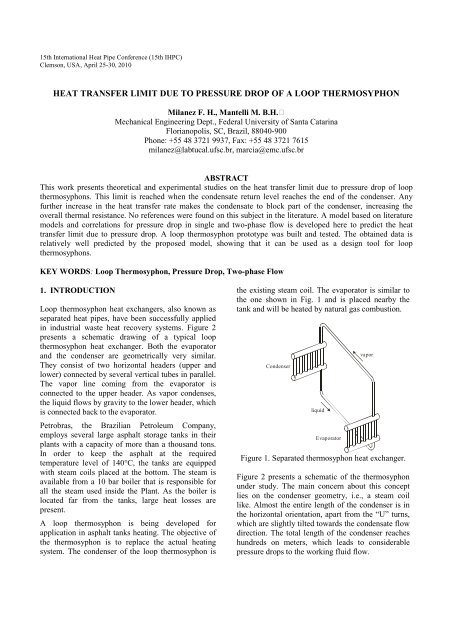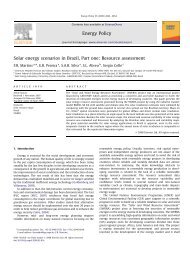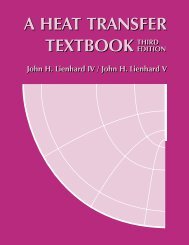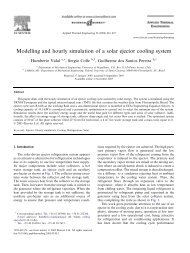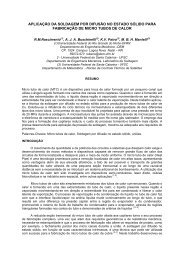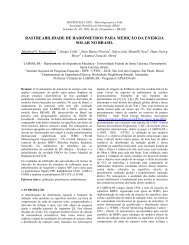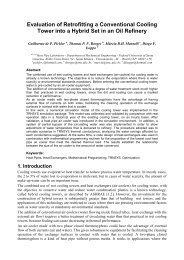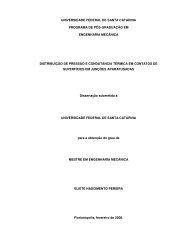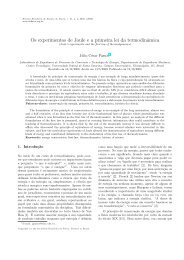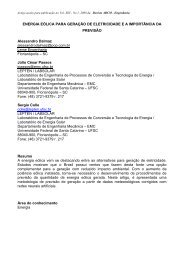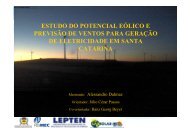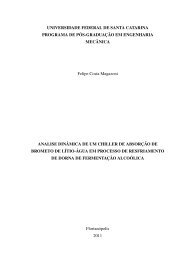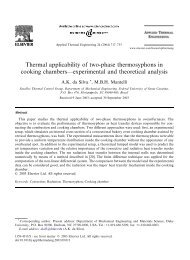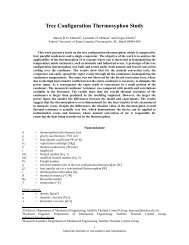heat transfer limit due to pressure drop of a loop ... - LEPTEN
heat transfer limit due to pressure drop of a loop ... - LEPTEN
heat transfer limit due to pressure drop of a loop ... - LEPTEN
You also want an ePaper? Increase the reach of your titles
YUMPU automatically turns print PDFs into web optimized ePapers that Google loves.
15th International Heat Pipe Conference (15th IHPC)<br />
Clemson, USA, April 25-30, 2010<br />
HEAT TRANSFER LIMIT DUE TO PRESSURE DROP OF A LOOP THERMOSYPHON<br />
Milanez F. H., Mantelli M. B.H.<br />
Mechanical Engineering Dept., Federal University <strong>of</strong> Santa Catarina<br />
Florianopolis, SC, Brazil, 88040-900<br />
Phone: +55 48 3721 9937, Fax: +55 48 3721 7615<br />
milanez@labtucal.ufsc.br, marcia@emc.ufsc.br<br />
ABSTRACT<br />
This work presents theoretical and experimental studies on the <strong>heat</strong> <strong>transfer</strong> <strong>limit</strong> <strong>due</strong> <strong>to</strong> <strong>pressure</strong> <strong>drop</strong> <strong>of</strong> <strong>loop</strong><br />
thermosyphons. This <strong>limit</strong> is reached when the condensate return level reaches the end <strong>of</strong> the condenser. Any<br />
further increase in the <strong>heat</strong> <strong>transfer</strong> rate makes the condensate <strong>to</strong> block part <strong>of</strong> the condenser, increasing the<br />
overall thermal resistance. No references were found on this subject in the literature. A model based on literature<br />
models and correlations for <strong>pressure</strong> <strong>drop</strong> in single and two-phase flow is developed here <strong>to</strong> predict the <strong>heat</strong><br />
<strong>transfer</strong> <strong>limit</strong> <strong>due</strong> <strong>to</strong> <strong>pressure</strong> <strong>drop</strong>. A <strong>loop</strong> thermosyphon pro<strong>to</strong>type was built and tested. The obtained data is<br />
relatively well predicted by the proposed model, showing that it can be used as a design <strong>to</strong>ol for <strong>loop</strong><br />
thermosyphons.<br />
KEY WORDS: Loop Thermosyphon, Pressure Drop, Two-phase Flow<br />
1. INTRODUCTION<br />
Loop thermosyphon <strong>heat</strong> exchangers, also known as<br />
separated <strong>heat</strong> pipes, have been successfully applied<br />
in industrial waste <strong>heat</strong> recovery systems. Figure 2<br />
presents a schematic drawing <strong>of</strong> a typical <strong>loop</strong><br />
thermosyphon <strong>heat</strong> exchanger. Both the evapora<strong>to</strong>r<br />
and the condenser are geometrically very similar.<br />
They consist <strong>of</strong> two horizontal headers (upper and<br />
lower) connected by several vertical tubes in parallel.<br />
The vapor line coming from the evapora<strong>to</strong>r is<br />
connected <strong>to</strong> the upper header. As vapor condenses,<br />
the liquid flows by gravity <strong>to</strong> the lower header, which<br />
is connected back <strong>to</strong> the evapora<strong>to</strong>r.<br />
Petrobras, the Brazilian Petroleum Company,<br />
employs several large asphalt s<strong>to</strong>rage tanks in their<br />
plants with a capacity <strong>of</strong> more than a thousand <strong>to</strong>ns.<br />
In order <strong>to</strong> keep the asphalt at the required<br />
temperature level <strong>of</strong> 140°C, the tanks are equipped<br />
with steam coils placed at the bot<strong>to</strong>m. The steam is<br />
available from a 10 bar boiler that is responsible for<br />
all the steam used inside the Plant. As the boiler is<br />
located far from the tanks, large <strong>heat</strong> losses are<br />
present.<br />
A <strong>loop</strong> thermosyphon is being developed for<br />
application in asphalt tanks <strong>heat</strong>ing. The objective <strong>of</strong><br />
the thermosyphon is <strong>to</strong> replace the actual <strong>heat</strong>ing<br />
system. The condenser <strong>of</strong> the <strong>loop</strong> thermosyphon is<br />
the existing steam coil. The evapora<strong>to</strong>r is similar <strong>to</strong><br />
the one shown in Fig. 1 and is placed nearby the<br />
tank and will be <strong>heat</strong>ed by natural gas combustion.<br />
Condenser<br />
liquid<br />
Evapora<strong>to</strong>r<br />
vapor<br />
Figure 1. Separated thermosyphon <strong>heat</strong> exchanger.<br />
Figure 2 presents a schematic <strong>of</strong> the thermosyphon<br />
under study. The main concern about this concept<br />
lies on the condenser geometry, i.e., a steam coil<br />
like. Almost the entire length <strong>of</strong> the condenser is in<br />
the horizontal orientation, apart from the “U” turns,<br />
which are slightly tilted <strong>to</strong>wards the condensate flow<br />
direction. The <strong>to</strong>tal length <strong>of</strong> the condenser reaches<br />
hundreds on meters, which leads <strong>to</strong> considerable<br />
<strong>pressure</strong> <strong>drop</strong>s <strong>to</strong> the working fluid flow.
The flow <strong>of</strong> working fluid inside a <strong>loop</strong><br />
thermosyphon is associated <strong>to</strong> a <strong>pressure</strong> <strong>drop</strong>. The<br />
larger is the <strong>heat</strong> <strong>transfer</strong> rate through the <strong>loop</strong><br />
thermosyphon, the larger is the working fluid velocity<br />
and the larger is the <strong>pressure</strong> <strong>drop</strong>. The <strong>pressure</strong> <strong>drop</strong><br />
<strong>due</strong> <strong>to</strong> the working fluid flow must be compensated<br />
by a hydraulic head between evapora<strong>to</strong>r and<br />
condenser. Figure 2 presents a schematic <strong>of</strong> this<br />
phenomenon. The hydraulic head h is the difference<br />
between the liquid levels in the evapora<strong>to</strong>r and in the<br />
condensate return line. The maximum allowable<br />
difference is h max , i.e., the vertical distance between<br />
evapora<strong>to</strong>r liquid pool surface and condenser bot<strong>to</strong>m.<br />
When the thermosyphon is at the <strong>heat</strong> <strong>transfer</strong> <strong>limit</strong><br />
<strong>due</strong> <strong>to</strong> <strong>pressure</strong> <strong>drop</strong>, h=h max . Any further increase in<br />
the <strong>heat</strong> <strong>transfer</strong> rate makes the condensate <strong>to</strong> block<br />
part <strong>of</strong> the condenser. A further increase in the <strong>heat</strong><br />
<strong>transfer</strong> rate leads <strong>to</strong> h>h max (see Fig. 3). The<br />
thermosyphon thermal resistance increases because<br />
the available are for two-phase <strong>heat</strong> <strong>transfer</strong><br />
increases. That is because only the portion <strong>of</strong> the<br />
condenser that can be reached by the vapor is<br />
effective for <strong>heat</strong> <strong>transfer</strong>. The portion <strong>of</strong> the<br />
condenser that is filled with condensate no longer<br />
operates in two-phase <strong>heat</strong> <strong>transfer</strong> mode.<br />
Figure 2. Hydraulic head h in a <strong>loop</strong> thermosyphon<br />
This work presents both theoretical and experimental<br />
studies on the <strong>heat</strong> <strong>transfer</strong> <strong>limit</strong> <strong>of</strong> <strong>loop</strong>thermosyphons.<br />
The main objective is <strong>to</strong> develop a<br />
model <strong>to</strong> help the design <strong>of</strong> <strong>loop</strong> thermosyphons.<br />
Under normal operation, the thermosyphon should<br />
operate in the condition shown in Fig.3, i.e., bellow<br />
the <strong>heat</strong> <strong>transfer</strong> <strong>limit</strong> <strong>due</strong> <strong>to</strong> <strong>pressure</strong> <strong>drop</strong>.<br />
Figure 3. Loop thermosyphon beyond the <strong>pressure</strong><br />
<strong>drop</strong> <strong>limit</strong><br />
2. THEORETICAL ANALYSIS<br />
When the hydraulic head <strong>due</strong> <strong>to</strong> working fluid flow<br />
<strong>pressure</strong> <strong>drop</strong> is equal <strong>to</strong> the vertical distance<br />
between the liquid pool level at the evapora<strong>to</strong>r and<br />
the bot<strong>to</strong>m <strong>of</strong> the condenser, the <strong>loop</strong> thermosyphon<br />
is reaching a <strong>heat</strong> <strong>transfer</strong> <strong>limit</strong>. In this work, this<br />
<strong>limit</strong> is called here “the <strong>heat</strong> <strong>transfer</strong> <strong>limit</strong> <strong>due</strong> <strong>to</strong><br />
<strong>pressure</strong> <strong>drop</strong>”. Any increase in the <strong>heat</strong> <strong>transfer</strong> rate<br />
makes the condensate level <strong>to</strong> fill up the condenser,<br />
blocking <strong>heat</strong> <strong>transfer</strong> and leading <strong>to</strong> the system’s<br />
failure. A theoretical model <strong>to</strong> predict the <strong>heat</strong><br />
<strong>transfer</strong> <strong>limit</strong> <strong>due</strong> <strong>to</strong> <strong>pressure</strong> <strong>drop</strong> is developed here.<br />
The model is based on literature correlations and<br />
models for viscous fluid flow <strong>pressure</strong> <strong>drop</strong>.<br />
The <strong>to</strong>tal <strong>pressure</strong> <strong>drop</strong> ∆P t <strong>of</strong> the working fluid flow<br />
is related <strong>to</strong> the hydraulic head h through the<br />
following expression:<br />
( ρ − ρ ) g h<br />
∆ P =<br />
(1)<br />
t<br />
l<br />
where g=9,81 m/s 2 . In this equation, the <strong>pressure</strong><br />
gradient resulting from momentum variation at the<br />
liquid-vapor interfaces were neglected.<br />
The <strong>to</strong>tal <strong>pressure</strong> <strong>drop</strong> ∆P t is the summation <strong>of</strong> the<br />
v
<strong>pressure</strong> <strong>drop</strong>s <strong>due</strong> <strong>to</strong> fluid flow at the evapora<strong>to</strong>r<br />
∆P evap , vapor line ∆P v , condenser ∆P cond and<br />
condensate return line ∆P l , i.e.:<br />
∆ P = ∆P<br />
+ ∆P<br />
+ ∆P<br />
+ ∆P<br />
(2)<br />
t<br />
evap<br />
v<br />
cond<br />
If the vapor line is well insulated so there is no<br />
condensation, the flow is single-phase (vapor). When<br />
the thermosyphon is operating at the <strong>limit</strong>, the<br />
condensate return line is filled with liquid (h=h max ),<br />
and the flow in the condensate return line is also<br />
single-phase. The single-phase flow <strong>pressure</strong> <strong>drop</strong><br />
can be calculated form classical fluid flow textbooks<br />
(Fox & McDonnald, 1988), such as:<br />
2<br />
Le<br />
ρ V<br />
∆ P = f<br />
(3)<br />
d 2<br />
i<br />
For smooth pipes, the friction coefficient can be<br />
computed as:<br />
0.316<br />
f =<br />
(4)<br />
0.25<br />
Re<br />
where Re, the Reynolds number is defined as:<br />
ρVD 4 q<br />
Re ≡ =<br />
(5)<br />
µ h lv<br />
π d i<br />
µ<br />
The equivalent length L e , appearing in Eq. (3) is the<br />
summation <strong>of</strong> the vapor line <strong>to</strong>tal length and the<br />
equivalent length <strong>of</strong> the bends, valves and other<br />
components <strong>of</strong> the circuit. The other two components<br />
<strong>of</strong> the <strong>pressure</strong> <strong>drop</strong> in Eq. (3), in the evapora<strong>to</strong>r and<br />
in the condenser, are more complex <strong>due</strong> <strong>to</strong> the twophase<br />
nature <strong>of</strong> the flow.<br />
The <strong>pressure</strong> <strong>drop</strong> in two-phase fluid flow has been<br />
the subject <strong>of</strong> several researches [2,3,4]. Two<br />
classical models have been developed: homogeneous<br />
model and separated model. In the homogenous<br />
model, the two phases flow at the same velocity. In<br />
the separated model, there is a non-zero relative<br />
velocity (shear) between the phases. The results <strong>of</strong><br />
two models are presented in the following sections.<br />
More details are provided in the references.<br />
2.1 Homogeneous model<br />
In the development <strong>of</strong> the homogeneous model for<br />
two-phase flow <strong>pressure</strong> <strong>drop</strong> it is assumed that the<br />
flow is one-dimensional and the liquid and vapor<br />
velocities are the same. In other words, the two<br />
phases are replaced by a hypothetical fluid with<br />
homogenous properties throughout all the points <strong>of</strong><br />
l<br />
the flow. According <strong>to</strong> Collier & Thome (1994), the<br />
<strong>pressure</strong> gradient is calculated as:<br />
−<br />
⎪⎧<br />
2 fTPG<br />
⎨<br />
dP<br />
=<br />
⎪⎩<br />
ρldi<br />
dz<br />
where:<br />
2<br />
⎡ ⎛ v ⎤<br />
lv<br />
⎞ g sin Ω<br />
⎢1<br />
+ x<br />
⎜<br />
⎟⎥<br />
+<br />
⎣ ⎝ vl<br />
⎠⎦<br />
l lv<br />
⎛ dv ⎞<br />
⎜ +<br />
2 v<br />
1 G x ⎟<br />
⎝ dP ⎠<br />
( v + x v )<br />
+ G<br />
2<br />
dx ⎪⎫<br />
vlv<br />
⎬<br />
dz ⎪ ⎭<br />
(6)<br />
m<br />
G = &<br />
(7)<br />
A<br />
q<br />
m & =<br />
(8)<br />
h lv<br />
m&<br />
v<br />
x = (9)<br />
m&<br />
−0,25<br />
⎛ G di<br />
⎞<br />
f<br />
TP<br />
= 0,079⎜<br />
⎟<br />
(10)<br />
⎝ µ ⎠<br />
The literature presents several definition for the<br />
equivalent viscosity µ . In this work, two models<br />
found in Wallis (1969) are used:<br />
v<br />
( x) l<br />
( 1−<br />
x)<br />
µ = x µ + 1 − µ (Cicchitti) (11)<br />
1 x<br />
= +<br />
µ µ<br />
v<br />
µ<br />
l<br />
(McAdams) (12)<br />
The second term in the denomina<strong>to</strong>r <strong>of</strong> Eq. (6) is<br />
related <strong>to</strong> the vapor compressibility and is normally<br />
neglected, so the denomina<strong>to</strong>r is approximately one.<br />
For the geometry <strong>of</strong> Fig. 3, the quality x [ ] is one at<br />
the condenser inlet and zero at the exit. Between the<br />
two points, the variation is assumed <strong>to</strong> be linear<br />
because the <strong>heat</strong> flux, and consequently the<br />
condensation rate, is uniform along the condenser<br />
length, i.e.:<br />
z<br />
x = 1 −<br />
(13)<br />
L cond<br />
The condenser <strong>pressure</strong> <strong>drop</strong> is finally computed as:<br />
∆P<br />
cond<br />
=<br />
∫<br />
0<br />
L cond<br />
dP<br />
dz<br />
dz<br />
(14)<br />
where L cond [m] is the <strong>to</strong>tal condenser length,<br />
including the equivalent lengths <strong>of</strong> the “U” bends. In<br />
this work, the equivalent length <strong>of</strong> one “U” turn is<br />
assumed <strong>to</strong> be 50 times the internal diameter <strong>of</strong> the
tube. This value was encountered in Fox &<br />
McDonnald (1988) for single-phase flow. Despite<br />
this is two-phase flow, the above value was used<br />
because <strong>of</strong> the lack <strong>of</strong> specific values.<br />
The set <strong>of</strong> equations above are solved numerically <strong>to</strong><br />
obtain the <strong>to</strong>tal <strong>pressure</strong> <strong>drop</strong> <strong>of</strong> the condenser. The<br />
condenser <strong>to</strong>tal length, including the equivalent<br />
length <strong>of</strong> the “U” bends, is divided in 100 parts. The<br />
<strong>pressure</strong> <strong>drop</strong> <strong>of</strong> each part is calculated considering<br />
constant values <strong>of</strong> the quantities given by Eqs. (6)<br />
and (10) <strong>to</strong> (13) within each part.<br />
2.2 Separated model<br />
As already mentioned, in the separated model, the<br />
two phases flow at different speeds. According <strong>to</strong><br />
Collier and Thome (1994), the expression for the<br />
local <strong>pressure</strong> gradient is:<br />
( 1−<br />
x)<br />
⎛<br />
2 2<br />
⎡<br />
⎤<br />
⎜ 2 2 f<br />
lG<br />
φl<br />
⎢<br />
⎥ +<br />
dP 1<br />
⎜ ⎣ ρldi<br />
⎦<br />
− = ⎜<br />
dz Λ ⎜ ⎪⎧<br />
2 dx ⎡ 2x<br />
2 1<br />
⎜G<br />
⎨⎢<br />
−<br />
dz<br />
⎝ ⎪⎩ ⎣ ρv<br />
α ρv<br />
[( 1−α<br />
) ρ + αρ ]<br />
( − x)<br />
( 1−α<br />
)<br />
l<br />
v<br />
⎤ dα<br />
⎡<br />
⎥ + ⎢<br />
⎦ dx ⎣ ρ<br />
g sin Ω +<br />
2<br />
2<br />
( 1−<br />
x)<br />
x ⎤⎪⎫<br />
− ⎥⎬<br />
( − ) ⎦<br />
⎟ ⎪⎭<br />
⎟⎟⎟⎟⎟ 2 2<br />
1 α ρvα<br />
v<br />
⎠<br />
(15)<br />
where Λ≈1, which means the vapor compressibility<br />
and can be neglected (Carey, 1992), similarly <strong>to</strong> the<br />
homogeneous model. The liquid friction coefficient is<br />
calculated in a similar fashion <strong>to</strong> Eq. (10), that is:<br />
f<br />
l<br />
⎡G<br />
= 0,079⎢<br />
⎣<br />
( 1−<br />
x)<br />
µ<br />
l<br />
d<br />
⎤<br />
⎥<br />
⎦<br />
i<br />
−0,25<br />
⎞<br />
(16)<br />
Several methods are presented in the literature <strong>to</strong><br />
determine the two-phase multiplier and the void<br />
fraction, most <strong>of</strong> them <strong>of</strong> empirical nature. Carey<br />
(1992) presents the correlations developed by<br />
Lockhart and Martinelli for these quantities:<br />
where:<br />
1/ 2<br />
⎛ C 1 ⎞<br />
φ<br />
l<br />
= ⎜1+<br />
+<br />
2<br />
⎟ (17)<br />
⎝ X X ⎠<br />
0,71 −<br />
( 1+<br />
0,28 ) 1<br />
α = X<br />
(18)<br />
X<br />
2<br />
⎛ dP ⎞<br />
⎜ ⎟<br />
⎝ dz ⎠<br />
=<br />
⎛ dP ⎞<br />
⎜ ⎟<br />
⎝ dz ⎠<br />
l<br />
v<br />
(19)<br />
This quantity is called the Martinelli Parameter,<br />
which is the ratio between the <strong>pressure</strong> <strong>drop</strong> that<br />
would occur if only the liquid phase was present and<br />
the <strong>pressure</strong> <strong>drop</strong> that would occur if only the vapor<br />
phase was present. These two <strong>pressure</strong> <strong>drop</strong>s are<br />
evaluated using equations for single phase flow:<br />
⎛ dP ⎞<br />
⎜ ⎟<br />
⎝ dz ⎠<br />
l<br />
⎛ dP ⎞<br />
⎜ ⎟<br />
⎝ dz ⎠<br />
v<br />
( x)<br />
2 flG<br />
2 1−<br />
= −<br />
ρ d<br />
2<br />
= −<br />
v<br />
l<br />
i<br />
i<br />
2<br />
fvG<br />
x<br />
ρ d<br />
2<br />
2<br />
(20)<br />
(21)<br />
The constant C which appears in Eq. (17) depends<br />
on the nature <strong>of</strong> the flows:<br />
• C=20 for turbulent liquid and vapor flow<br />
• C=12 for turbulent vapor and laminar liquid<br />
flow<br />
• C=10 for laminar vapor and turbulent liquid<br />
flow<br />
• C=5 for laminar liquid and vapor flow<br />
Carey (1992) present other models for the two-phase<br />
multiplier. Wallis (1969) proposes a model where<br />
liquid and vapor flow in separated tubes with distinct<br />
diameters, but with the same <strong>to</strong>tal area as the actual<br />
tube. Furthermore, the <strong>pressure</strong> <strong>drop</strong>s <strong>of</strong> the two<br />
flows must be equal <strong>to</strong> the <strong>pressure</strong> <strong>drop</strong> <strong>of</strong> the<br />
actual flow. For turbulent flow, it yields:<br />
19<br />
16<br />
16<br />
⎡ ⎤<br />
1 19<br />
⎢ ⎛ ⎞<br />
φ 1 ⎥<br />
l<br />
= + ⎜ ⎟<br />
(22)<br />
⎢ ⎝ X ⎠ ⎥<br />
⎣ ⎦<br />
Finally, the friction coefficient for the liquid phase is<br />
calculated with Eq. (16) while the friction coefficient<br />
for the vapor phase is calculated with:<br />
f<br />
v<br />
⎡Gxd<br />
= 0,079 ⎢<br />
⎣ µ<br />
v<br />
⎤<br />
⎥<br />
⎦<br />
i<br />
−0,25<br />
(23)<br />
Similarly <strong>to</strong> the homogenous model, the <strong>to</strong>tal length<br />
<strong>of</strong> the condenser is divided in 100 parts and the <strong>to</strong>tal<br />
<strong>pressure</strong> <strong>drop</strong> is calculated numerically as the<br />
summation <strong>of</strong> the <strong>pressure</strong> <strong>drop</strong>s <strong>of</strong> the 100 parts.<br />
Within each part the quantities given by Eqs. (13)<br />
and (15) <strong>to</strong> (23).
3. EXPERIMENTAL STUDY<br />
3.1. Experimental Set-Up<br />
A stainless steel-water <strong>loop</strong> thermosyphon pro<strong>to</strong>type<br />
was built and tested for the <strong>heat</strong> <strong>transfer</strong> <strong>limit</strong> <strong>due</strong> <strong>to</strong><br />
<strong>pressure</strong> <strong>drop</strong>. The condenser is a stainless-steel 6<br />
mm internal diameter and 11 m horizontal tube with<br />
several “U” bends. Figure 4 shows a schematic <strong>of</strong> the<br />
experimental set-up. The pro<strong>to</strong>type maximum<br />
allowable hydraulic head (Fig. 2) is h max =2 m. The<br />
evapora<strong>to</strong>r is a horizontal cylinder with cartridge<br />
<strong>heat</strong>ers immersed in the liquid pool. The <strong>heat</strong> <strong>transfer</strong><br />
is computed as the electric power input <strong>to</strong> the <strong>heat</strong>ers<br />
minus the thermal insulation losses.<br />
The condenser is inserted in a controlled thermal bath<br />
with (ethylene-glycol) in the forced convection. The<br />
temperature <strong>of</strong> the thermal fluid is controlled through<br />
a LAUDA® PR855 controlled temperature thermal<br />
bath.<br />
The evapora<strong>to</strong>r <strong>of</strong> the model is made <strong>of</strong> a SS 316<br />
horizontal tube with 100 mm i.d. and 400 mm long.<br />
The working fluid is distillated water and the filling<br />
ratio is 80% <strong>of</strong> the evapora<strong>to</strong>r volume. The vapor line<br />
is connected <strong>to</strong> the <strong>to</strong>p <strong>of</strong> the horizontal cylinder,<br />
while the liquid return line is connected <strong>to</strong> the side <strong>of</strong><br />
the cylinder, below the liquid pool level. Heat is<br />
provided by eight 20 mm o.d. cartridge type electrical<br />
<strong>heat</strong>ers immersed in the liquid pool. The entire<br />
system is insulated with glass wool, with the thermal<br />
losses estimated in 100 W. By measuring the<br />
electrical resistance and the current, the <strong>heat</strong> power<br />
input could be accurately assessed.<br />
The condenser could also be tilted with respect <strong>to</strong><br />
the horizontal position (see tilt angle θ in Fig. 4).<br />
However, preliminary measurements showed the<br />
system is not greatly affected by this angle. This is<br />
because most part <strong>of</strong> the condenser remains in<br />
horizontal orientation, regardless <strong>of</strong> the tilt angle.<br />
Only the “U” bends experience change in the<br />
orientation as the tilt angle is varied. All the tests<br />
presented here are for θ= 13°.<br />
The condenser was instrumented with seven K-type<br />
thermocouples distributed evenly over its length.<br />
The first thermocouple was placed 50 mm from the<br />
start <strong>of</strong> the condenser. The seventh thermocouple<br />
was placed 50 mm from the end <strong>of</strong> the condenser.<br />
Figure 5 present the thermocouple distribution. The<br />
vapor line was instrumented with one K-type<br />
thermocouple next <strong>to</strong> the evapora<strong>to</strong>r exit. The<br />
evapora<strong>to</strong>r was instrumented with two K-type<br />
thermocouples: one immersed in the liquid pool and<br />
one immersed in the vapor space above the liquid<br />
pool. The controlled thermal bath was measured by<br />
two K-type thermocouples, one at the inlet and one<br />
at the outlet. The temperature, voltage and current<br />
were measured with a HP 3947-A® Data<br />
Acquisition System connected <strong>to</strong> a personal<br />
computed, which s<strong>to</strong>red the data for further<br />
treatment.<br />
vapor<br />
condenser<br />
θ<br />
liquid<br />
evapora<strong>to</strong>r<br />
controled<br />
temperature<br />
bath<br />
Figure 4. Experimental set-up.<br />
Figure 5. Thermocouple distribution.
3.2. Tests Procedure<br />
The <strong>heat</strong>er was turned on starting from the thermal<br />
equilibrium with the ambient. The power input was<br />
first set <strong>to</strong> 1000 W. After the system reached steady<br />
state, the power input was increased by steps <strong>of</strong> 500<br />
W. In each power step, the system was left <strong>to</strong> reach<br />
steady state. Before the system reached the <strong>heat</strong><br />
<strong>transfer</strong> <strong>limit</strong> <strong>due</strong> <strong>to</strong> <strong>pressure</strong> <strong>drop</strong>, the condenser<br />
thermocouples give virtually the same reading, which<br />
is above the controlled thermal bath, showing the<br />
vapor reached the condenser entire length and it is<br />
<strong>transfer</strong>ring <strong>heat</strong> <strong>to</strong> the thermal bath. After the system<br />
exceeded the <strong>limit</strong>, the condensate level floods part <strong>of</strong><br />
the condenser (Fig. 4). This can be easily noticed by<br />
inspecting the thermocouple readings, which give the<br />
same readings as the thermocouples <strong>of</strong> the thermal<br />
bath. In this case, that part <strong>of</strong> the condenser is<br />
inactive for <strong>heat</strong> <strong>transfer</strong>. At this point, the test was<br />
finished and the <strong>heat</strong>er was turned <strong>of</strong>f.<br />
This procedure was repeated for several mean<br />
temperature levels <strong>of</strong> the thermosyphon. The mean<br />
temperature level was varied by changing the<br />
temperature level <strong>of</strong> the controlled thermal bath.<br />
3.3. Experimental Uncertainty<br />
After calibration <strong>of</strong> the system, the uncertainty in<br />
temperature measurement is ±0.60°C in the range <strong>of</strong><br />
temperatures <strong>of</strong> interest. The uncertainty in voltage<br />
measurement is ±0.1%, and the uncertainty <strong>of</strong> the<br />
<strong>heat</strong>er electrical resistance value was found <strong>to</strong> be<br />
±4%.<br />
The separated model with the two-phase multiplier<br />
computed using Wallis’ model yielded the best<br />
agreement with the measured data. The other<br />
models/correlations predicted lower values for the<br />
<strong>heat</strong> <strong>transfer</strong> <strong>limit</strong> <strong>due</strong> <strong>to</strong> <strong>pressure</strong> <strong>drop</strong>.<br />
In order <strong>to</strong> understand how the authors knew<br />
whether the thermosyphon reached the <strong>heat</strong> <strong>transfer</strong><br />
<strong>limit</strong> or not, let’s examine Fig. 7. It presents the<br />
temperature readings as a function <strong>of</strong> time for the<br />
controlled thermal bath set at 150°C. As one can see,<br />
the evapora<strong>to</strong>r temperatures (103 and 104, Fig. 5)<br />
are very close <strong>to</strong>gether and approximately 20°C<br />
above the condenser temperatures (106 <strong>to</strong> 112). The<br />
condenser temperature readings also relatively close<br />
<strong>to</strong> each other, with the maximum temperature<br />
difference <strong>of</strong> approximately 4°C. The difference <strong>of</strong><br />
temperature readings between the first (106) and the<br />
last (112) condenser temperature is less than 0.8°C,<br />
which shows that the condenser cooling is<br />
approximately isothermal. For time
temperature [°C]<br />
condenser (112), which means the system exceeded<br />
the <strong>heat</strong> <strong>transfer</strong> <strong>limit</strong> de <strong>to</strong> <strong>pressure</strong> <strong>drop</strong>. Therefore<br />
one concludes that the <strong>limit</strong> lies between <strong>heat</strong> <strong>transfer</strong><br />
rates <strong>of</strong> 3.9 kW and 4.4 kW. The measured <strong>heat</strong><br />
<strong>transfer</strong> <strong>limit</strong> is defined here as the average <strong>of</strong> the two<br />
values, i.e., approximately 3.15kW. The <strong>limit</strong> was<br />
reached when the thermosyphon mean temperature<br />
was 178°C (average <strong>of</strong> the thermocouple readings<br />
from 103 <strong>to</strong> 112).<br />
All the data points presented in the graph <strong>of</strong> Fig. 6<br />
were obtained using the procedure described above.<br />
The uncertainty <strong>of</strong> this procedure is 500W, which is<br />
the test power step. The amplitude <strong>of</strong> the error bar is<br />
therefore 500W. The error bar then indicates that the<br />
<strong>limit</strong> could be actually anywhere within that range.<br />
180<br />
175<br />
170<br />
165<br />
160<br />
155<br />
100 102 104 106 108 110 112 114 116<br />
time [min]<br />
thermocouple 112<br />
Figure 7. Temperature reading as a function <strong>of</strong> time.<br />
5. CONCLUSIONS<br />
This work presented theoretical and experimental<br />
studies on the <strong>heat</strong> <strong>transfer</strong> <strong>limit</strong> <strong>due</strong> <strong>to</strong> <strong>pressure</strong> <strong>drop</strong><br />
<strong>of</strong> <strong>loop</strong> thermosyphons. This <strong>limit</strong> is specially<br />
important for large <strong>pressure</strong> <strong>drop</strong>s systems, such as<br />
<strong>heat</strong>ing systems where the condenser is a long steam<br />
coil. When the thermosyphon exceeds this <strong>limit</strong>, the<br />
condensate blocks part <strong>of</strong> the condenser, increasing<br />
the overall thermal resistance.<br />
A model is proposed here, which is based on<br />
literature models and correlations for <strong>pressure</strong> <strong>drop</strong> in<br />
both single and two-phase flows. A pro<strong>to</strong>type was<br />
built and tested for the <strong>heat</strong> <strong>transfer</strong> <strong>limit</strong> <strong>due</strong> <strong>to</strong><br />
<strong>pressure</strong> <strong>drop</strong>. The data is relatively well predicted by<br />
the proposed model. The model can then be<br />
employed as a <strong>loop</strong> thermosyphon design <strong>to</strong>ol, so the<br />
thermosyphon can operate safely bellow this <strong>limit</strong>.<br />
103<br />
104<br />
105<br />
106<br />
107<br />
108<br />
109<br />
110<br />
111<br />
112<br />
113<br />
114<br />
115<br />
116<br />
NOMENCLATURE<br />
A cross sectional area [m 2 ]<br />
C constant (see Eq. 18)<br />
d i inner diameter [m]<br />
f friction coefficient [ ]<br />
G mass flux [kg/s.m 2 ]<br />
h hydraulic head<br />
h lv latent <strong>heat</strong> <strong>of</strong> vaporization [J/kg]<br />
L length [m]<br />
m& mass flow rate [kg/s]<br />
P thermodynamic <strong>pressure</strong>[Pa]<br />
q <strong>heat</strong> <strong>transfer</strong> rate [W]<br />
Re Reynolds number<br />
v specific volume (=1/ρ) [m³/kg]<br />
V velocity [m/s]<br />
x vapor quality [ ]<br />
X 2 Martinelli Parameter<br />
z coordinate axis along the flow[m]<br />
Subscripts<br />
evap evapora<strong>to</strong>r<br />
cond condenser<br />
e equivalent<br />
l liquid<br />
v vapor<br />
TP two-phase<br />
Greek letters<br />
α void fraction ( = A )[ ]<br />
A v<br />
φ<br />
l<br />
two-phase multiplier [ ]<br />
µ absolute viscosity [Pa.s]<br />
ρ density [kg/m³]<br />
Ω tube tilt angle [°]<br />
ACKNOWLEDGEMENT<br />
The authors would like <strong>to</strong> acknowledge the support<br />
<strong>of</strong> PETROBRAS, the Brazilian Petroleum Company,<br />
during this research.<br />
REFERENCES<br />
1. Fox, R. W. & McDonald, A. T., Introdução à<br />
Mecânica dos Fluidos, Guanabara Koogan, 3 a .<br />
Edição, Rio de Janeiro, 1988.<br />
2. Collier, J. G. and Thome, J. R., Convective<br />
Boiling and Condensation, Clarendon Press, 3 rd<br />
Edition, Oxford, 1994.<br />
3. Wallis, G. B., One-dimensional Two-phase<br />
Flow, McGraw-Hill, 1969.<br />
4. Carey, V. P., Liquid-Vapor Phase-Change<br />
Phenomena, Taylor & Francis, 1992.


